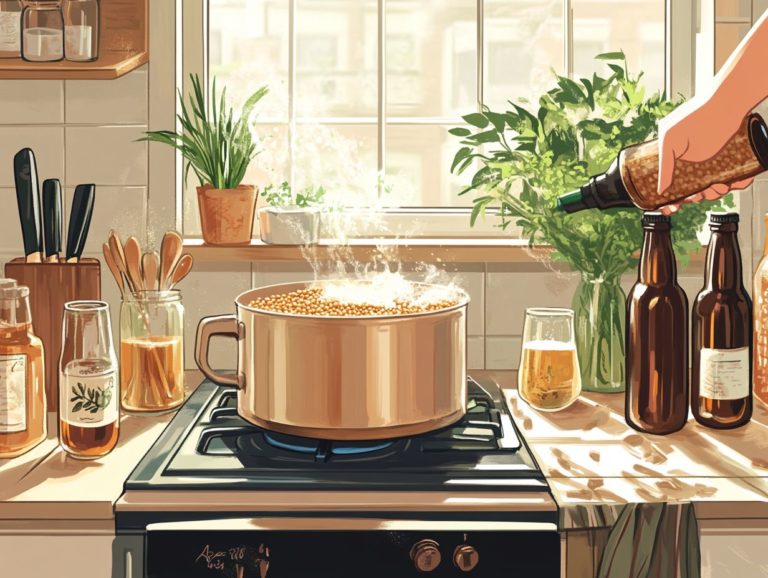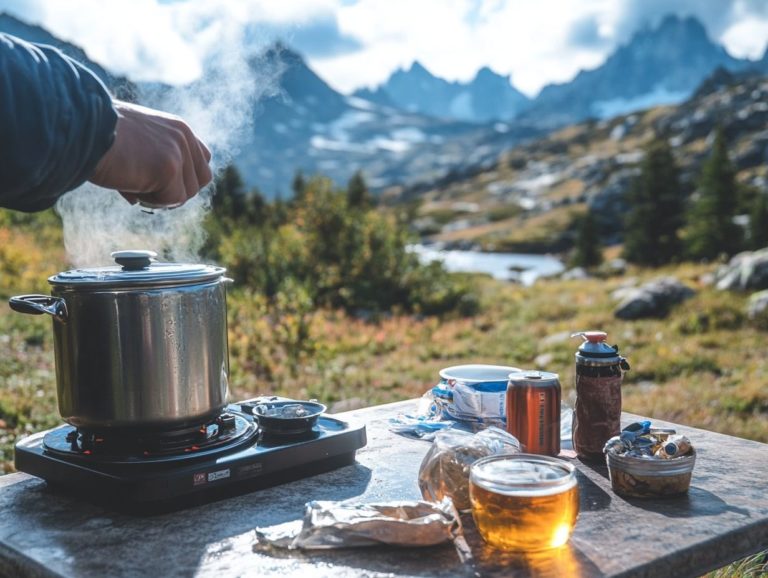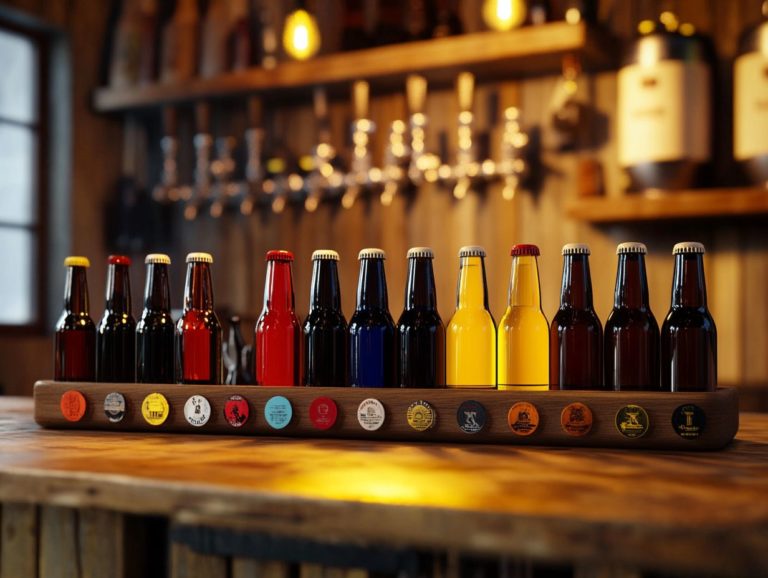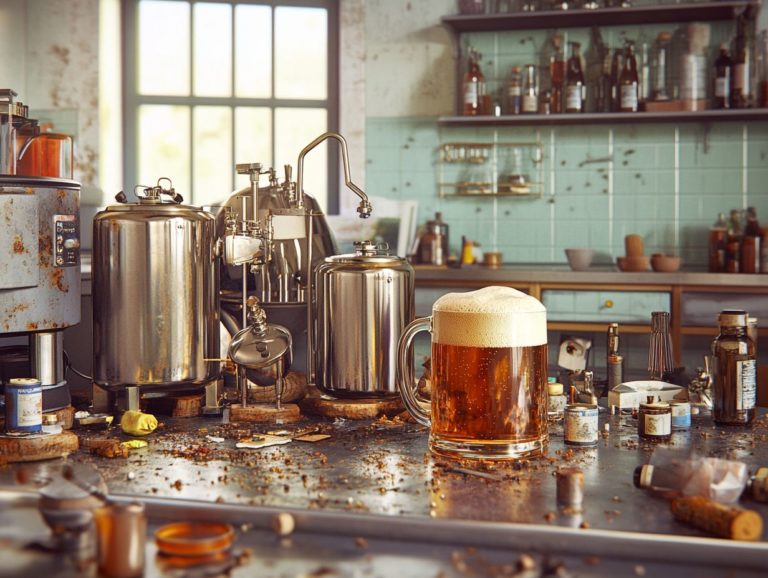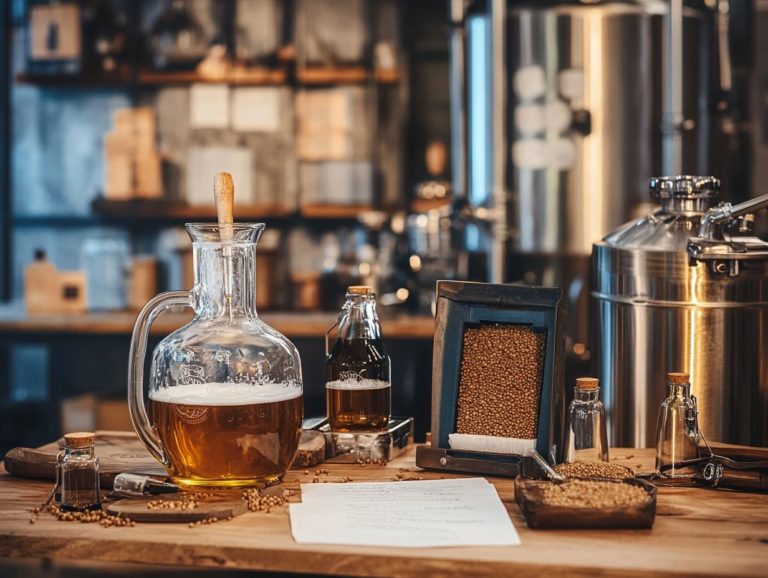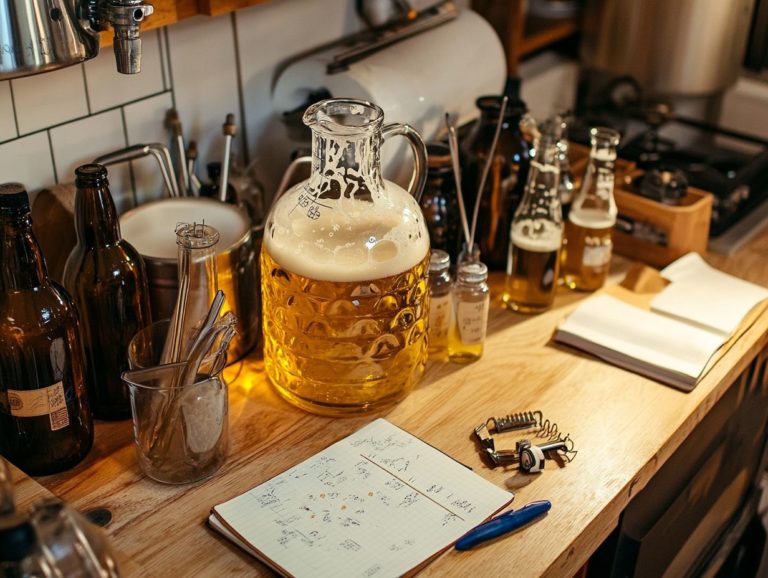What Is Home Brewing?
Home brewing is a rewarding hobby that invites you to craft your very own beer right in the comfort of your home. Imagine creating your own craft beer in your kitchen! With roots tracing back to the Neolithic period, this practice has blossomed into a beloved pastime for many enthusiasts.
Delve into the captivating history of home brewing and uncover the myriad reasons individuals choose to brew their own beer. You ll want to familiarize yourself with the essential brewing equipment and beer ingredients necessary to start this adventure.
Whether your motivation stems from cost savings, a desire for creativity, or a quest for quality control, there s a wealth of knowledge awaiting you in this enjoyable craft of brewing beer.
Explore the intricacies of the brewing process, identify common pitfalls, and gather invaluable tips for success. Understand the legal and safety considerations that come with home brewing.
Contents
- Key Takeaways:
- What Is Home Brewing?
- History of Home Brewing
- Why Do People Home Brew?
- What Do You Need to Start Home Brewing?
- How to Home Brew Beer
- 1. Choosing a Recipe
- 2. Preparing the Ingredients
- 3. The Brewing Process
- 4. Fermentation and Bottling
- Common Mistakes in Home Brewing
- Tips for Successful Home Brewing
- Is Home Brewing Legal?
- Is Home Brewing Safe?
- Frequently Asked Questions
Key Takeaways:
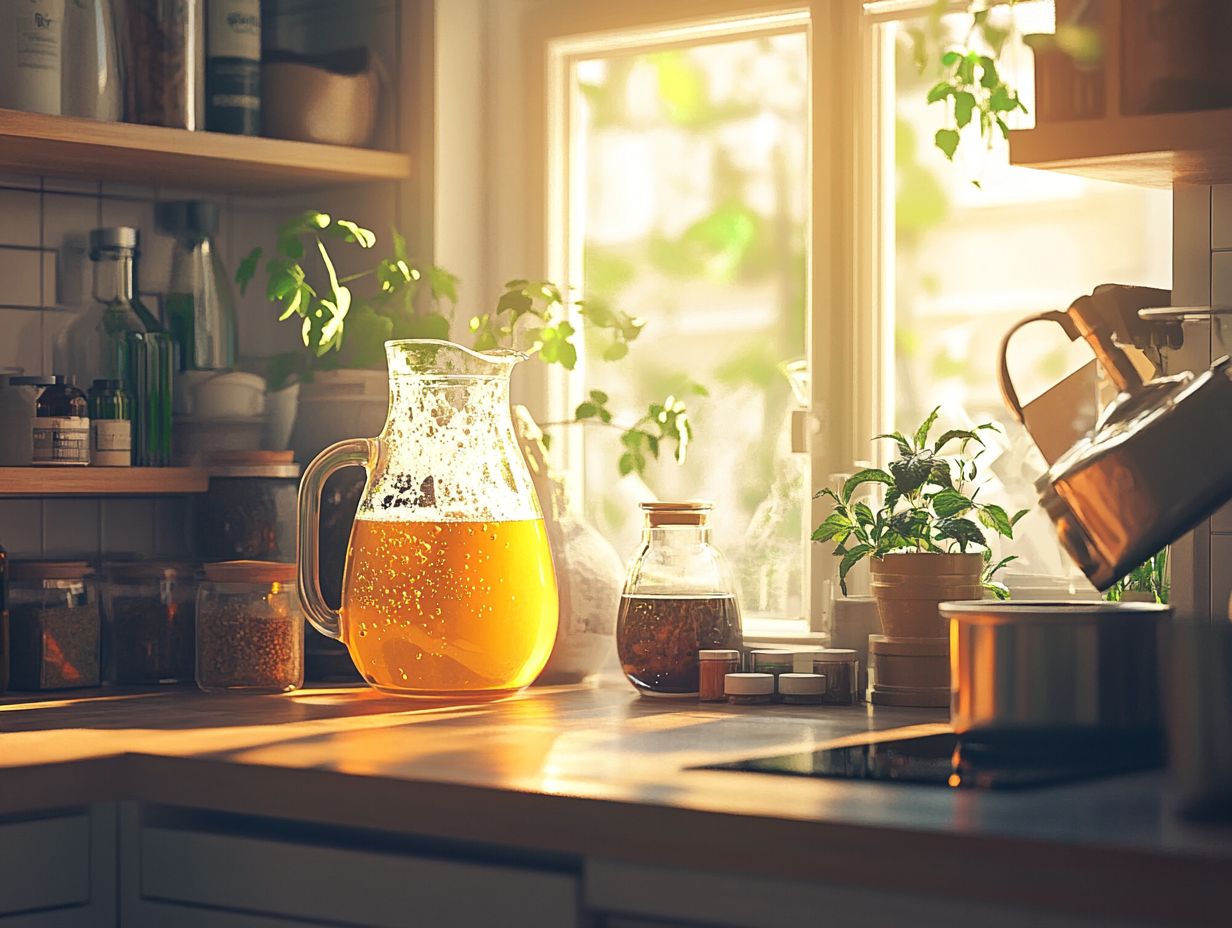
- Home brewing refers to the process of making beer, wine, or other alcoholic beverages at home using basic brewing equipment and ingredients.
- People home brew for various reasons, including cost savings, creativity, and quality control.
- To start home brewing, you need basic equipment, ingredients, and sanitization products, along with following a beer recipe carefully.
What Is Home Brewing?
Home brewing is the art of crafting beer, wine, or other beverages right in your own kitchen, using a variety of ingredients such as malt, hops, and yeast to create distinctive flavors and styles. This ancient beverage technique allows you to explore various brewing methods.
This time-honored practice has seen a resurgence in popularity across the United States, inviting enthusiasts like you to explore an array of beer recipes and brewing techniques. Organizations such as the American Homebrewers Association and events like Homebrew Con have further fueled this interest.
Whether you re in the mood for a refreshing light ale or a robust stout, the journey of creating your own home brewed beer elevates the entire experience, turning brewing into a delightful adventure. The conditioning, aging, and carbonation process further enhance the final product.
History of Home Brewing
The history of home brewing is a fascinating tapestry that stretches back thousands of years, tracing its roots to the Neolithic period when ancient civilizations first discovered the art of fermenting grains to create alcohol. This early practice laid the foundation for the modern home brewing landscape you enjoy today. Early brewing methods were crucial in shaping the ancient beverage culture.
As centuries passed, home brewing underwent significant transformations, particularly during the Industrial Revolution, a time when innovations in brewing equipment and techniques flourished. This movement gained further momentum thanks to influential figures like Jimmy Carter, who championed home brewing legislation in the United States, and organizations such as the American Homebrewers Association, which have passionately supported enthusiasts and education in the art of brewing. Notably, the creation of Billy Beer by Jimmy Carter s brother, Billy Carter, also brought attention to home brewing.
Why Do People Home Brew?
You may engage in home brewing for a variety of reasons, whether it s the allure of saving money on craft beer or the thrill of unleashing your creativity with unique beer recipes tailored to your personal palate. This passion for brewing enables you to take control of the quality of your ingredients and the fermentation process, offering a rewarding hands-on experience. Beginner brewing techniques especially cater to newcomers looking to explore this hobby.
Beyond the technical aspects, home brewing cultivates a sense of community among fellow amateur brewers, especially those embarking on their journey with beginner brewing techniques. This shared interest often leads to gatherings and exchanges of brewing tips and beer judge certification experiences.
1. Cost Savings
One of the primary reasons you might find yourself drawn to home brewing is the substantial cost savings it offers compared to buying commercial craft beer. This way, you can indulge your passion for high-quality beverages without breaking the bank.
By investing in some basic brewing equipment and supplies, you embark on a hobby that not only fuels your creativity but also yields significant financial benefits over time. While the initial investment in essentials like kettles, fermenters, and bottles may appear intimidating, the ongoing expenses for ingredients such as malt, hops, and yeast strains are relatively modest.
In fact, when you crunch the numbers on the price per pint, you ll often find that brewing your own beer can cost a mere fraction of what you’d pay for store-bought options. This leads to remarkable savings, especially for those who truly savor the experience of enjoying a cold, fresh brew right from the comfort of home. The use of malt extract in brewing also simplifies the process and reduces costs.
2. Creativity and Experimentation
Home brewing presents an exceptional opportunity for you to unleash your creativity and indulge in experimentation, allowing you to develop your own beer recipes and explore an array of unique flavors not typically found in commercial options.
By incorporating diverse ingredients like unique hop varieties and unconventional yeast strains, you can push the boundaries of traditional flavors and craft distinctive brews that truly reflect your personal tastes. The process transforms into a joyful journey where experimentation takes center stage, enabling you to discover unexpected pairings and styles along the way. Louis Pasteur s contributions to microbiology have also significantly impacted modern brewing techniques.
Current trends such as the rise of sour ales and fruit-infused recipes showcase how innovative techniques can lead to refreshing alternatives to classic beers. Ultimately, the satisfaction of creating a one-of-a-kind beverage tailored to your palate makes the brewing experience all the more rewarding. BrewZilla home brewing systems are popular among enthusiasts for their versatility in experimenting with such trends.
3. Quality Control

Quality control stands as a pivotal element in your home brewing journey, allowing you to meticulously monitor each step of the fermentation process and ensuring that your beer aligns perfectly with your personal standards and preferences.
By maintaining a rigorous focus on quality, you can fine-tune your recipes and techniques to achieve that sought-after flavor profile and consistency. This means managing crucial variables such as temperature, sanitation, and ingredient selection, all of which play vital roles in the brewing process. For example, keeping fermentation temperatures steady will greatly influence yeast activity and, ultimately, the taste of your brew. Additionally, practicing proper sanitation is essential, as any contaminants can lead to unpleasant off-flavors. Saccharomyces cerevisiae is a common yeast strain used in home brewing to achieve desired flavor profiles.
Regularly tasting samples throughout the brewing stages enables you to identify potential issues early on, enabling you to make adjustments for future batches. By prioritizing quality control and being proactive in your brewing practices, you can truly elevate your craft and create exceptional home-brewed beer.
What Do You Need to Start Home Brewing?
Embarking on your journey into home brewing demands a solid grasp of the essential components involved. This begins with acquiring a comprehensive home brewing kit, which typically includes vital brewing equipment like fermenters, fermentation locks, and an array of tools designed to streamline the brewing process. These kits often come with detailed instructions and tips to help beginners get started on the right foot.
1. Basic Equipment
The essential equipment for home brewing encompasses various items typically found in a home brewing kit, including a fermentation lock and a fermenter. These important tools make brewing easier and streamline the process. Attending brewing workshops or conferences can also provide hands-on experience with this equipment.
Gaining an understanding of the function of each piece of equipment can significantly elevate your brewing experience. Whether you’re just starting out or have been honing your craft for years, it’s vital to know how each tool works. For instance, the fermentation lock is essential! It allows gases to escape during fermentation while keeping contaminants at bay, ensuring that your brew remains pure and untainted.
The fermenter, often crafted from glass or food-grade plastic, is where the real magic happens. It transforms sugars into alcohol through the action of yeast. A hydrometer becomes your best friend, enabling you to measure specific gravity a measure of the density of your liquid compared to water and determine the sugar content before and after fermentation.
Other tools, such as a bottle capper and sanitizer, are equally essential, guaranteeing that the final product is not only flavorful but also safe for your enjoyment. Proper sanitization is critical to prevent contamination and preserve the quality of your home brewed beer.
2. Ingredients
The Role of Each Ingredient
The quality of your home-brewed beer hinges significantly on the selection of ingredients, including malt extract, hops, and yeast strains. These components collectively shape the flavor and alcohol content of your creation. Understanding the role of each ingredient helps in crafting a beer that meets your specific taste preferences.
Choosing the right malt is essential; it not only influences the sweetness but also infuses your brew with distinct colors and aromas that elevate the final product. Different malts, such as pale malt and specialty malts, serve specific functions tailored to the styles of beer you wish to craft. Barley is a common type of malt used in many brewing styles.
Hops are another cornerstone of the brewing process. They bring bitterness that perfectly balances the sweetness of the malt, while also adding enticing floral and fragrant notes crucial for certain ales and IPAs. The hops used in brewing can vary widely, affecting the bitterness, flavor, and aroma of the beer.
Let s not overlook yeast! Often underestimated, yeast is vital in fermenting sugars and producing alcohol while contributing unique characteristics to the beer. Yeast strains like Saccharomyces cerevisiae are commonly used to achieve the desired fermentation results.
By grasping the roles of these ingredients, you can choose high-quality options that align with your desired flavor profiles, ensuring each batch embodies your individual brewing vision.
3. Sanitization Products and Techniques
Sanitization products play an essential role in home brewing. They ensure that the fermentation process remains free from contaminating bacteria that can compromise the quality of your home-brewed beer. This critical step can be the defining factor between a delightful batch and one that turns out spoiled or simply unpleasant.
Proper sanitization is crucial for protecting the delicate yeast involved in fermentation, allowing it to perform its magic without interference from unwanted microorganisms. Act quickly! A clean brewing environment is your best defense against spoilage.
As you explore effective methods, consider using a variety of sanitizers, such as iodine-based solutions or no-rinse formulas that streamline the process. Avoid common pitfalls like using soaps or failing to adequately rinse your equipment. These mistakes can lead to undesirable off-flavors in your brew.
To avoid these issues, always adhere to the manufacturer’s instructions and ensure that every surface comes into contact with sanitizer. Remember, maintaining a pristine environment is paramount to achieving that perfect pint.
How to Home Brew Beer
Home brewing beer is an exhilarating and fulfilling endeavor that encompasses several essential steps. You begin by selecting a beer recipe that captures your interest, followed by meticulously preparing the ingredients.
The journey continues through the brewing process, where your vision starts to take shape, led by the magic of fermentation. Finally, you ll bottle your creation, allowing it to carbonate and transform into a delightful beverage that reflects your craft.
1. Choosing a Recipe
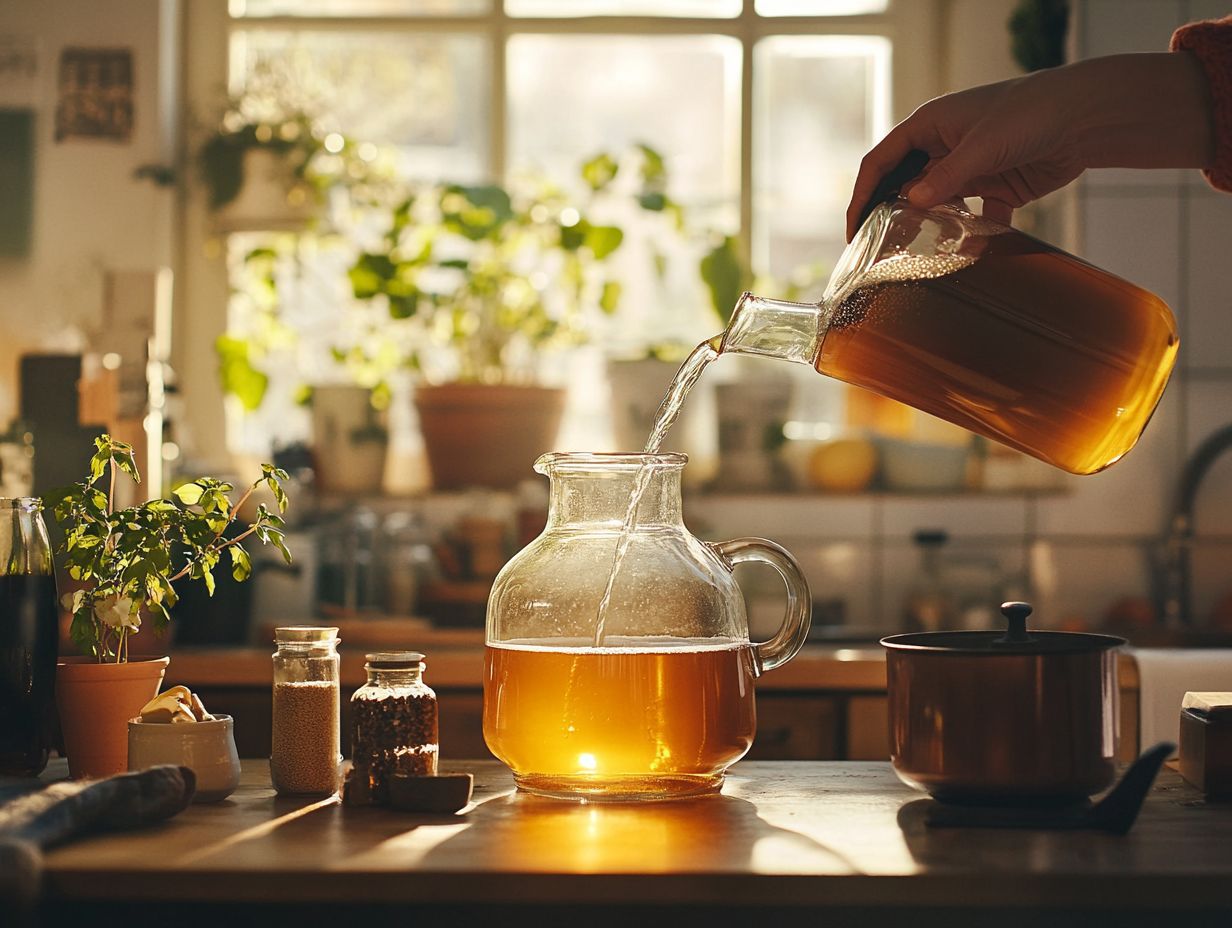
Choosing a beer recipe is the first and most crucial step in your home brewing journey. This decision sets the foundation for the entire brewing process and allows you to focus on your preferred style and flavors.
When selecting a recipe, consider your personal taste. It will significantly influence your enjoyment of the final product. Think about the complexity of the brew; if you re a beginner, you might lean towards straightforward recipes like a pale ale or a wheat beer, which require minimal ingredients and equipment. On the other hand, if you re more seasoned, you might savor the challenge of crafting intricate styles such as a Belgian Dubbel or a stout.
Don’t overlook the availability of ingredients either. Some recipes may call for specific hops or malts that can be tricky to find. Ultimately, by understanding these elements, you enable yourself to craft the ideal beer that reflects your unique preferences.
2. Preparing the Ingredients
Preparing your ingredients for brewing beer requires careful measuring and thoughtful selection of key components like malt, hops, and yeast strains. Each of these elements plays a crucial role in shaping the flavor profile and overall quality of your final product.
Selecting high-quality malt is non-negotiable; it directly influences the sweetness, color, and body of your beer while striking the perfect balance of sugars for fermentation.
Choose hops based on their aroma and bitterness. These attributes can either enhance or overpower the other flavors in your brew, so choose wisely.
The yeast strain you select is equally important, as it s responsible for fermentation, determining alcohol content, and adding unique esters and phenols that give your beer its distinctive character.
To ensure consistency and promote a successful brewing process, employ precise measuring techniques utilize a scale for dry ingredients and a graduated cylinder for liquids. With these practices in place, you’re well on your way to creating a remarkable brew.
3. The Brewing Process
Get ready for an exciting journey as you begin mashing! The brewing process is a harmonious blend of science and artistry, where you skillfully combine selected malt extract, hops, and other ingredients, cooking them to extract rich flavors before cooling down for fermentation.
Your journey begins with mashing, where heated water activates enzymes in the malt, converting starches into sugars an essential step for achieving a balanced final product. Once mashing is complete, you separate the liquid, now known as wort (the liquid extracted from the mash), from the spent grains and bring it to a vigorous boil.
This boiling stage is crucial; it not only sterilizes the wort but also extracts essential flavors and aromas from the hops, enriching the character of your beer.
After the boil, you rapidly cool the wort to a temperature perfect for adding yeast, marking the exciting transition into fermentation. Here, yeast works its magic, consuming the sugars and releasing alcohol and carbon dioxide, fundamentally transforming your wort into beer.
To achieve optimal results, your attention to detail at each stage is paramount. Maintaining precise temperatures and timing is essential, as even the slightest deviation can influence the final flavor profile and overall quality of your brew.
4. Fermentation and Bottling
Fermentation is not just a step in home brewing; it s the magic moment when your brewed mixture transforms into alcohol. Once that s done, you start bottling, which may involve some conditioning and aging to elevate the flavors along with a carbonation process to achieve that delightful fizz.
This stage typically spans from one to three weeks, depending on the brew you re crafting. Throughout fermentation, you ll want to keep a close eye on the specific gravity using a hydrometer. This handy tool reveals the sugar content and lets you track your alcohol production.
To reach those ideal flavors and optimal carbonation, maintaining a consistent temperature suited to your yeast strain is key. Once fermentation wraps up, it s time to transfer your beer into sanitized bottles, adding a priming sugar solution that s essential for carbonation as the yeast continues its work during bottle conditioning.
Best practices emphasize cleanliness at every stage and allowing your beer enough time to mature. Aging can significantly enhance the overall profile, resulting in a smoother, more developed beverage that you ll be proud to share.
Common Mistakes in Home Brewing
Home brewing can be an incredibly rewarding endeavor, yet it often comes with common pitfalls that you, as a beginner, might encounter. Inadequate sanitization and incorrect fermentation temperatures can compromise the final product.
These mistakes not only undermine the overall quality of your beer, but they can also introduce off-flavors that detract from the taste you envisioned. For example, neglecting to thoroughly sanitize your brewing utensils can result in unwanted bacterial growth, drastically impacting the fermentation process.
Maintaining inconsistent fermentation temperatures can hinder yeast activity and prevent the ideal conversion of sugars into alcohol. To truly elevate the quality of your home brewed beer, it’s vital to pay careful attention to both the cleaning process and temperature control.
By prioritizing these aspects, you ll set the stage for a successful and enjoyable brewing experience.
Tips for Successful Home Brewing
Get ready to dive into these essential tips for home brewing success! This includes not only properly maintaining your brewing equipment but also closely monitoring the fermentation process and experimenting with a variety of beer recipes.
By carefully selecting high-quality ingredients like malt, hops, and yeast, you can significantly enhance the flavor profile of your creations. Precise temperature control during fermentation is paramount, as it directly influences both the quality and taste of your final product.
Routine cleaning and sanitization of your brewing tools are practices you cannot overlook; they are essential in preventing unwanted infections that could spoil a batch. Keeping a detailed brewing log helps you improve over time and ensures consistency in your future brews.
Is Home Brewing Legal?
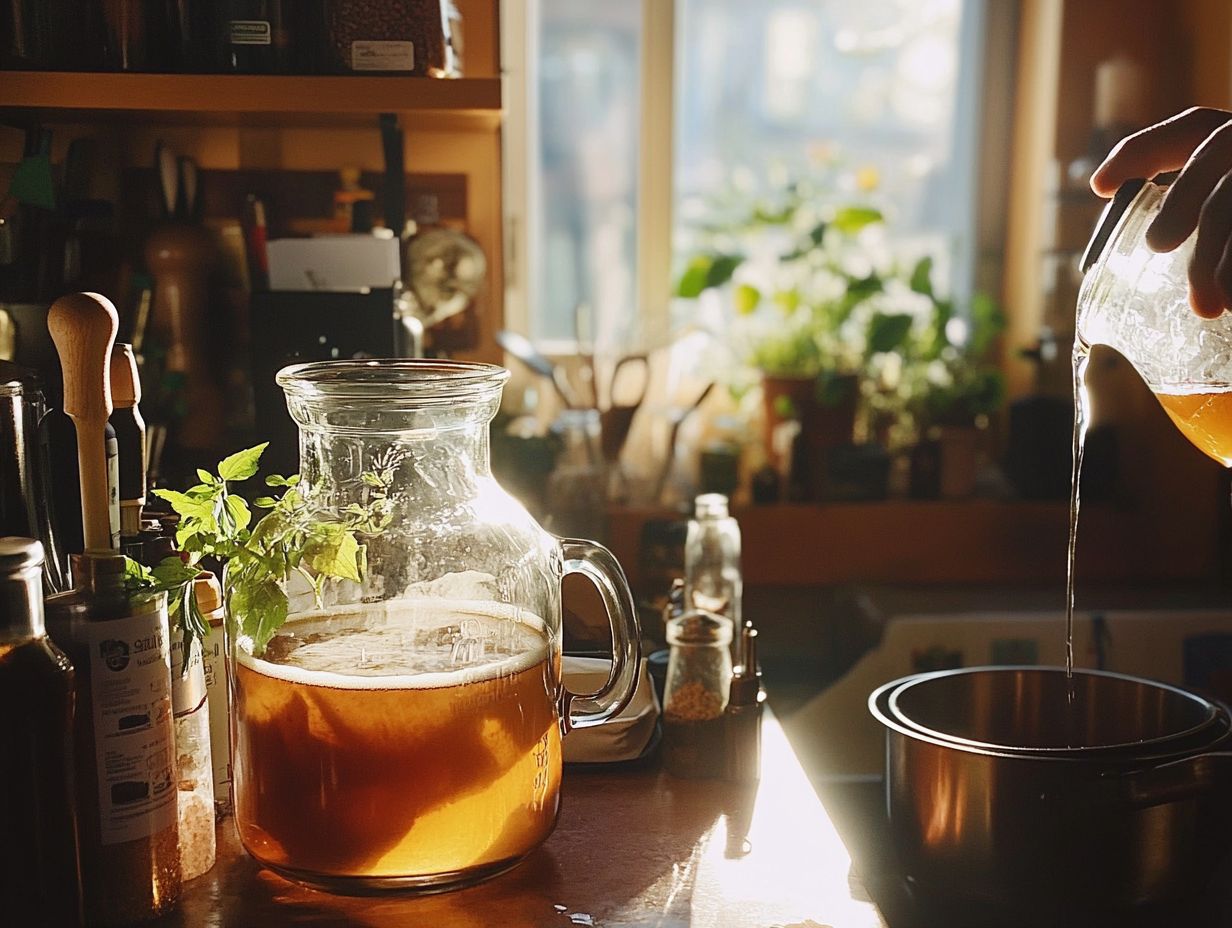
In the United States, home brewing is legal under federal law, largely thanks to the efforts of Jimmy Carter in the late 1970s. His advocacy allowed individuals like you to produce small quantities of beer for personal use without the burden of taxation.
This pivotal change transformed the legal landscape, legitimizing a cherished tradition while sparking a thriving craft beer movement across the nation. While federal law lays down a foundational framework, you ll encounter a wide variety of state regulations that create a complex quilt of laws for home brewers to navigate.
Some states embrace more permissive laws that encourage creative brewing endeavors, while others impose strict limits and even require permits for production. Over time, advocates for your cause have tirelessly pushed for reform, leading to a gradual easing of restrictions.
This progress enables enthusiasts to engage more freely in their craft, fostering a vibrant community of amateur brewers who share your passion.
Ready to start your home brewing journey? Share your experiences or ask questions!
Is Home Brewing Safe?
Home brewing is an exciting adventure! With the right techniques and sanitation, you can create your very own high-quality beer at home. Safety plays a pivotal role in home brewing, where using proper techniques during fermentation and adhering to stringent sanitary practices can effectively ward off contamination and guarantee the quality of your homebrewed beer.
Among the essential safety considerations, sanitation is very important. You must wash and sanitize all utensils, fermenters, and storage bottles thoroughly with suitable cleaners. Using clean brewing equipment is critical; any lingering residues or microorganisms can ruin the entire brewing process. Handle your equipment carefully to avoid breakage, as shards of glass can present a significant hazard.
Maintaining a consistent temperature throughout fermentation is equally critical, as drastic fluctuations can lead to off-flavors or spoilage. Make sure your brewing area is well-ventilated and free of distractions like eating or drinking, fostering a safe and focused environment for your brewing endeavors. Additionally, using a fermentation lock, which is a device that allows gases to escape during fermentation while keeping contaminants out, can help maintain the appropriate conditions during this critical stage.
These measures enhance your brewing experience and help create a delicious, high-quality product. Whether you are brewing beer or wine, adhering to these practices ensures that your ancient beverage retains its intended flavors and alcohol content.
Frequently Asked Questions
What Is Home Brewing?
Home brewing is the process of making beer, wine, or other alcoholic beverages at home using basic ingredients and equipment. This practice has roots dating back to the Neolithic period, highlighting its long-standing cultural significance.
What equipment do I need for home brewing?
To start home brewing, you will need a large pot for boiling, a fermenting vessel, an airlock, a hydrometer, and bottles for storing the finished product. You can also purchase a home brewing kit that includes all the necessary equipment. Many home brewers also use malt extract to simplify the brewing process.
Is home brewing legal?
In most countries, it is legal to brew your own beer or wine at home for personal consumption. This legality was significantly influenced by the efforts of the American Homebrewers Association and the signing of H.R. 1337 by President Jimmy Carter in 1978. However, before you start brewing, make sure to check your local laws. You wouldn t want to run into any legal troubles!
What ingredients are used in home brewing?
The main ingredients used in home brewing are water, malted barley, hops, and yeast. Saccharomyces cerevisiae is a popular yeast strain used for fermentation. Other ingredients such as fruit, spices, and herbs can also be added to create unique flavors.
How long does home brewing take?
The time it takes to brew at home varies depending on the type of beverage, recipe, and fermentation time. Generally, it can take anywhere from two weeks to several months. The conditioning and aging steps are also crucial in determining the final quality of your home brewed beer.
Can I customize my own beer recipe for home brewing?
Yes, one of the joys of home brewing is the ability to customize your own beer recipe and experiment with different ingredients and flavors. You can also find many beer recipes online to get started.

